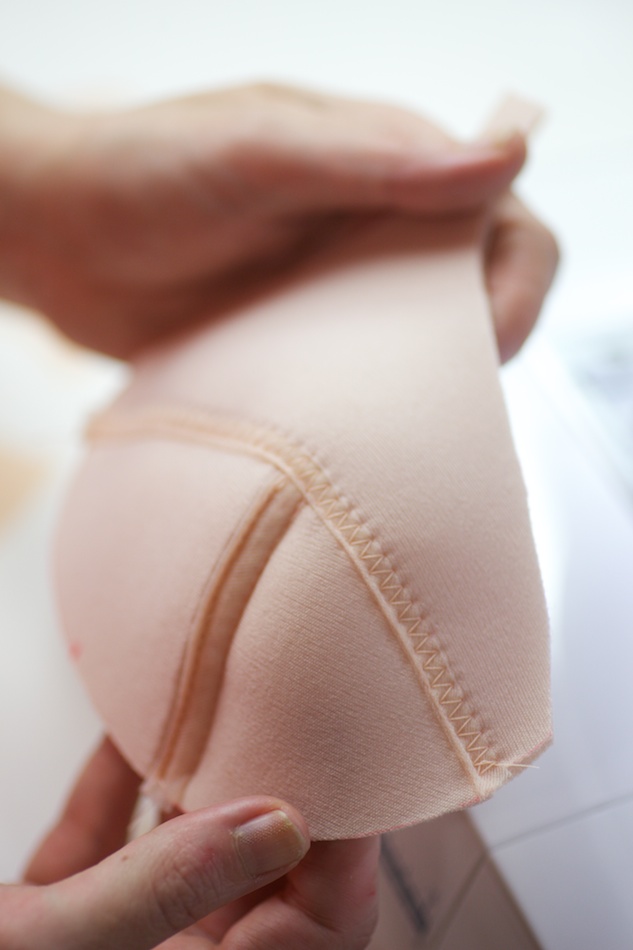
Today I’ll be cutting out my pieces and get started sewing. First, let’s make some some changes to your cup pattern to work with foam.
As I mentioned yesterday, these techniques can be used with any bra cups. I’d recommend starting with a pattern that you are familiar with making. It can have any kind of seaming. If your favorite bra pattern is a frameless bra (Kwik Sew 3300 is one example of these), there are tricks to stitching in the channeling in such a way that doesn’t fold the foam back on itself. I couldn’t cover that here, but hopefully this tutorial will give you a good place to start!
Here’s the pattern I’ll be working with:

Sometimes I make these cups with a strap extension but for this tutorial I made a straight neckline to make things easier to follow.
[Edited to Add: The pattern I am using is not a commercial bra pattern for sale, but rather my own self-drafted pattern. If you are interested in turning a two-piece cup into a 3-piece cup, you might want to have a look at this tutorial.]
Pattern Alterations
1. Retrace your cup pieces so that you have two sets: one for the main cup fabric and one for the foam. It’s really a good idea to trace what will be your foam pieces onto some kind of heavier weight paper (card stock, watercolor paper, manila folder, anything that keeps its edge will do).
2. On the foam cup pieces, you’ll need mark in and remove all seam allowances along these three areas: the seams that go across the cup, the underarm, and the neckline. Don’t remove the seam allowances where the cup joins the cradle (the wire seam).
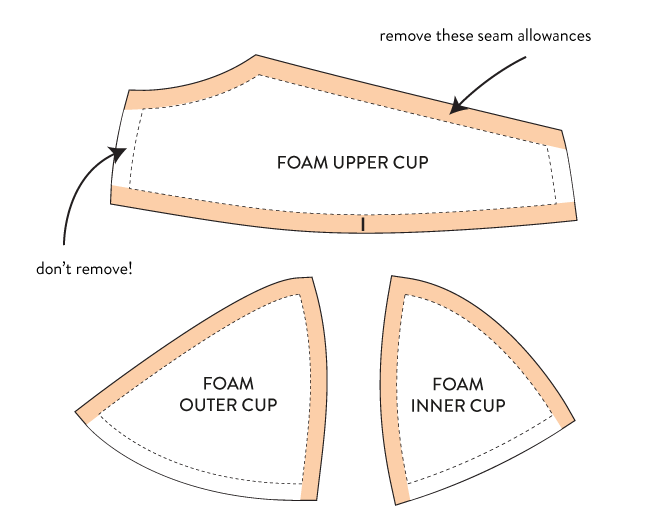
Most bra patterns have 1/4″ (6 mm) seam allowances around all these edges, or don’t have seam allowances so you have to add them. I find it a good practice to keep seam lines marked in all my bra patterns so I can made accurate adjustments.
3. Next I consider how I want to finish my neckline. For this tutorial, I’m making a clean finish neckline, in which the cup fabric will roll neatly over the top of the cup.
On the fabric cup pattern, add a 3/8″ allowance to the underarm seam and the neckline. Half of this is seam allowance and the other half is cloth allowance for folding over the thickness of the foam.
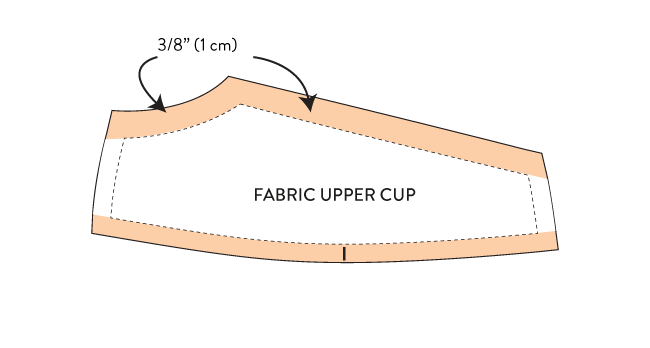
There are other ways to finish the neckline. If you want to bind the entire neckline with something like foldover elastic, you would cut off the neckline seam allowances from both the foam and main cup pieces.
If you want scalloped lace along the edges, you’d also cut off the neckline SAs from both foam and main cup pieces. I also shave a little bit more off the foam neckline on top of that–about 1/8″–so that it doesn’t peek out above the scallops.
Cutting
Now that all the pieces are ready, let’s get everything cut. When cutting from the foam, I gently hold down the pieces and trace around them with a ball point pen. (Sharpies and markers will bleed and make indefinite lines. Chalk and wax pencils don’t show up.)
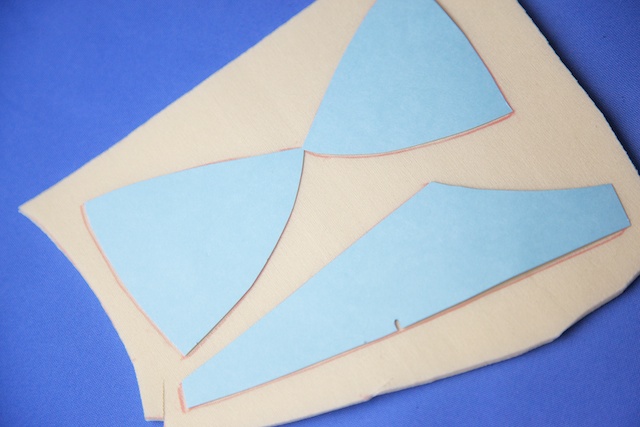
Cut away the lines…
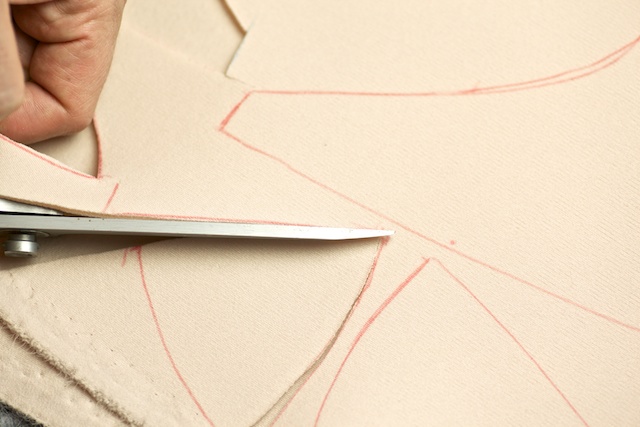
I also make tiny dots near the edge to mark the notch points (no snipping).
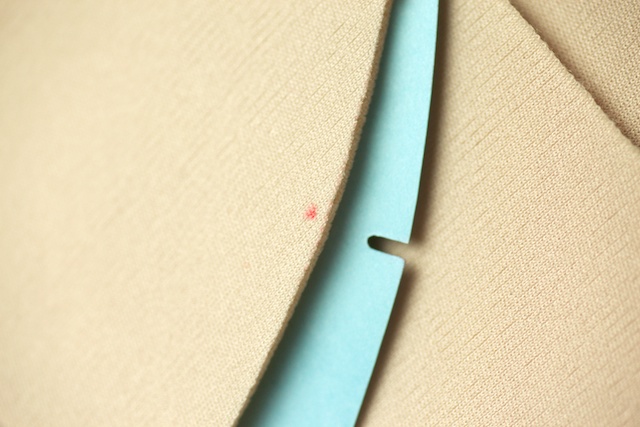
Foam Cup Assembly
1. To assemble the foam cups, butt the pieces together so that the foam lies edge to edge and is centered right under your presser foot. You’re going to zig-zag them together. You can use either a triple zig-zag or regular zig-zag. Whatever width you use, make sure it is wide enough to catch both sides of the butted seam.
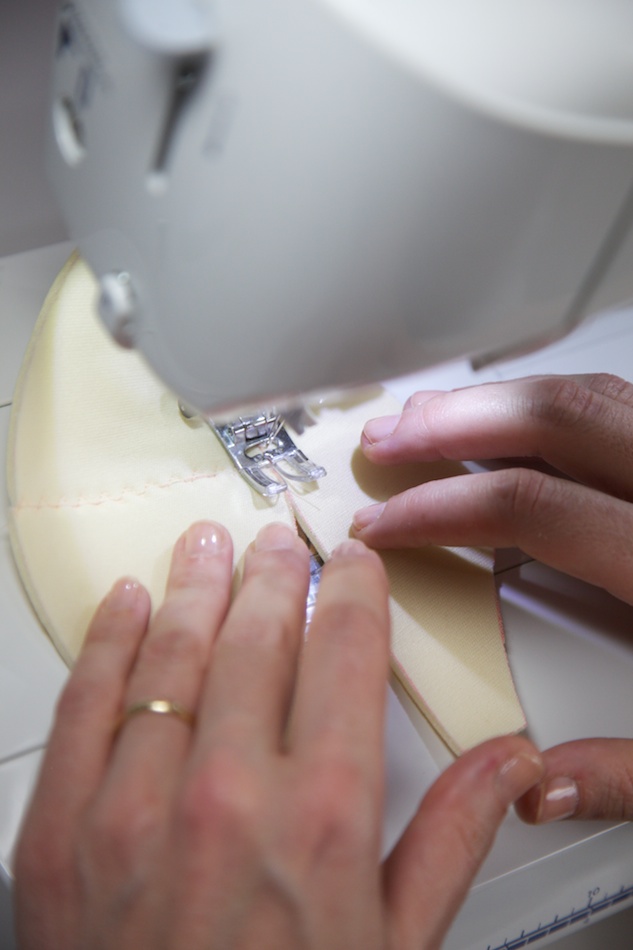
As I am sewing, I am trying to gently butt the edges against each other without leaving a gap, or without forcing or squishing the edges together.
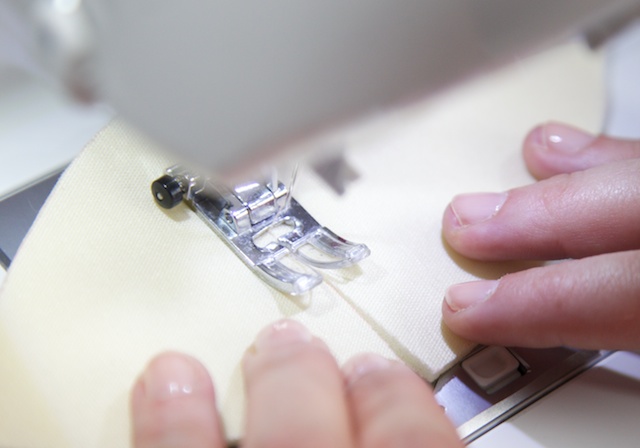
And here’s what it looks like stitched up:

2. Totally optional: At this point I can consider the foam cups finished, but sometimes I like to cover the inside seams. Covering the seams can add a bit of support to the cup and make it prettier. But don’t feel like this is necessary–there’s nothing wrong with leaving them uncovered.
I’ve tried a few different seam coverings. Narrow cotton twill tape makes a neat, trim covering but it has no give. I also tried a single layer of tricot seam tape but this was far too flimsy. My favorite is a wide bias seam tape that has been folded into thirds.
First I cut 3/4″ strips of tricot along the bias. Then I pressed each side under by a little less than 1/4″ so that the resulting width of the folded tape was just a smidge over 1/4″ (6mm). I centered this folded tape over my foam seams and stitched down each side of the tape.
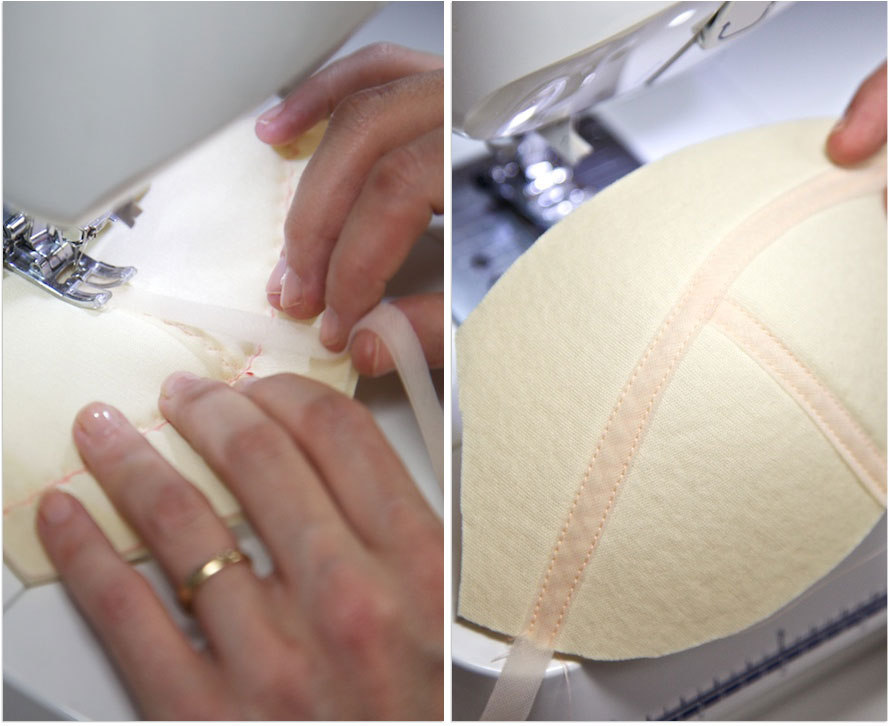
You can also zig-zag down the tape (see the very top photo of this post). Sometimes stitching down either side can be tricky when you are first getting used to working with tricot. This stuff can be slithery and chiffon-like but it makes such a soft and delicate lining. I even use it as seam tape to cover delicate seams in silk dresses because it practically disappears and never ravels.
3. Now go ahead and assemble your main fabric cups.

At this point you should have two sets of cups, one from foam and one from your outer fabric. On Monday I’ll finish off by showing how I cover the cups and stitch them into the cradle. In the meantime, you can go ahead and assemble your band the way you normally do and add your hem elastic.
Happy weekend!
See more posts in the series Make a Foam Cup Bra.
Would you like tips and inspiration in the craft of lingerie sewing? Sign up for my weekly eletter The Lingerie Maker.

I’ve never heard of this tricot seam tape stuff, what’s the brand name and where do you get it? Can’t wait to see how you join the tricot to the foam, I like the coverage of a foam cup, but not the way that molded cups are molded to any shape but mine…
Hi CG, it is not pre-made tape (nor a brand). I cut my own bias tape from sheer nylon tricot, which is very widely available, and pretty cheap. Almost anyone selling bra supplies, or a store specializing in dance or stretch fabrics, will have it. (See my sources page–you’ll find it at most of these!) A nude color is good to have around as it disappears under most colors. You may be familiar with “Seams Great”, a seam tape product that’s been around forever. This is a 1/2″ precut nylon tricot tape. But I find it much cheaper to cut my own, and I already use tricot to line bra cups so I have extra on hand. The Seams Great is too narrow for my purposes as well. I prefer a wider tape than I can fold, just like you would with any kind of folded bias tape. Hope that helps!
This is super!
This is great! I was thinking you must zig-zag stitch the foam together, and it’s so good to see your example!
Love all your tutorials Amy!
I’ve recently made a few of the foam cup bras (for myself and for my niece) — which I truly thought I wouldn’t like (I was afraid of adding something that seemed like padding to my already oversized bustline :P!). But, to my surprise, I absolutely love them, and am enjoying your tips!
Hey, have you tried one of the Pilot FriXion pens for tracing the foam shapes? I bought mine at a quilting shop, but they’re on Amazon too. Anyway, they’re a gel roller type pen that makes a nicely visible sharp thin line, that vanishes with (even very low) heat. I’ve been using one to trace (and mark notches on) my foam cup pieces and then I allow a whiff of steam from the iron near them after stitching together and POOF the line is gone! I LOVE LOVE LOVE these pens — great for marking buttonholes too.
That sounds like a really cool pen! I’m always adding different tracing tools to my arsenal as not every pen/chalk wheel/whatever works on every fabric. For the foam I cut away my lines so there is no pen left except the teeny dots which get hidden in the tape .
You are just awesome sauce! I am gathering all this info together to give it a try soon! I made your lady shorts pattern and they came out great.. I have a bit of caboose in the back so I need a bit more coverage! Otherwise they are awesome thanks so much for all of your help!
Your tutorials are really great! To be honest, I was skeptical at first about home sewing and bra making colliding, but you make it work and the techniques are very close to industry standards. I look forward to reading more and I think you may have persuaded me to give bra making a go again. BTW- super excited to find out that Spandex House carries the foam!
I wish I knew how to sew bras or how to sew period :’-(
I bought the bra makers manual and the depth of knowledge is amazing.
MAybe when my zig zags stoop looking like zigs I’ll accomplish making a bra, lol
I hope you learn! It’s really addictive… takes some practice but like anything else gets easier and easier. May your zigs turn into zigzags!
may i know from where i will be able to find this pattern ?
I am starting on a bodice structured dress and have been looking for a tutorial on the cups and this is exactly what I have been looking for! I love that you have sites to purchase the materials since I am new to this! My question about the foam padding is does it form and make the cup shape when sew together or does it form after you have it together? My outer fabric just lays flat.
Hi Jamie, whatever pattern you are using for the cups is the form the foam will take. If you look at my pattern pieces, you can see that a bra cup is basically a series of curved darts and when sewn together form a cup. I am using a customized bra cup pattern, but for your own cups you’ll either need a cup pattern (if your pattern doesn’t have one) or perhaps you’ll need to use pre-formed molded cups. Does that help?
Very helpful! Thank you so much!
I just found your website and I think I struck gold.
Well done!
Would you mind giving more detail on how you press the nylon tricot? How hot your iron is, do you use a press cloth, or just press directly on the nylon. I’ve found the tricot doesn’t seem to hold the folds when I press at lower heats, but don’t want it to melt.
Hi Catherine, you may be surprised to hear that I finger press! It isn’t perfect but I make a finger crease. Then when I run it under the machine I keep my fingers on the fold and topstitch close to the fold. A lot of nylon tricot is fussy and just won’t hold a crease. I wouldn’t raise the heat on your iron. It *will* melt. (Speaking from experience, and it is a pain to get off.)
A lot of people have asked me about how I sew that seam cover and I have some other solutions I like to use. You have given me a good idea for a future post!
With dis beautiful piece, i’m eager to try my hands on bra making.
MIL GRACIAS BENDICIONES
thks a lot, i will do it for the top of a wedding dress i am sewing…..thks!!!!
Hi, I love your web site. Can you tell me where I can purchase “Tricot covered foam bra material”.
Thank you so much,
Jan
Hi Janet,
In the first post of this series I list different types of foam and where to find them. All of them have some form of tricot material on the outside.